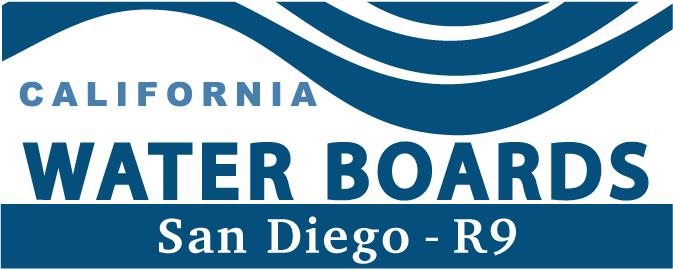San Diego Region - Ambient Biological Assessment Monitoring Program for Inland Surface Water
Introduction
In 1998, the San Diego Regional Water Quality Control Board (RWQCB) initiated a four-year ambient biological assessment monitoring program. The objectives of the program were:
- Evaluate the biological and physical integrity of inland surface waters in the San Diego Region;
- Identify potential reference conditions;
- Develop and test a regional Index of Biotic Integrity; and
- Develop a baseline of data to support the development of biological criteria for the San Diego Region.
This monitoring effort was a dramatic expansion of the RWQCB's historical ambient monitoring efforts, which have emphasized water column chemistry. Bioassessment is a cost-effective biological monitoring tool that utilizes measures of the stream's benthic macroinvertebrate (BMI) community and its physical/habitat structure. BMIs have a diverse community structure with individual species residing within the stream for periods ranging from weeks to several years. Because they are ubiquitous and sensitive in varying degrees to anthropogenic pollutants and other stressors, BMIs can provide considerable information regarding the biological condition of water bodies. Bioassessments integrate the effects of changing water quality conditions over time and are sensitive to multiple aspects of water and habitat quality. The additive or synergistic affects of multiple stressors, including the cumulative effects of sub-lethal doses of toxins, are reflected in changes in the community composition and structure in the stream benthos. Furthermore, bioassessment can accurately discriminate between natural and human caused changes in water or habitat quality and provides an expression of the ecological health of a river or stream.
The Ambient Bioassessment Monitoring Program utilized the California Stream Bioassessment Procedure (CSBP) developed by the California Department of Fish and Game and the California Aquatic Bioassessment Workgroup. The CSBP is a regional adaptation of the U.S. Environmental Protection Agency's rapid bioassessment protocols that has been developed and improved since 1994. The CSBP is a multi-metric approach to bioassessment. In a multi-metric approach, the suite of metrics (each measuring a different attribute of the benthic community) that exhibit the strongest response to human caused changes in the stream are combined into a single score, the Index of Biotic Integrity (IBI). The IBI is the end point of a multi-metric approach recommended by the US EPA for the development of biocriteria
The ambient bioassessment program and the Index of Biotic Integrity (IBI) provide critical information to assess the condition of the Region's waters. This information has and will continue to be used by the San Diego Regional Water Quality Control Board in:
- Clean Water Act Section 305(b) Water Quality Assessments;
- Clean Water Act Section 303(d) list of impaired water bodies;
- Clean Water Act Section 401 Water Quality Certification of dredge and fill projects;
- Waste Discharge Requirements for Non-Chapter 15 facilities;
- NPDES Municipal Storm Water Permits;
- Development of Total Maximum Daily Loads (TMDLs);
- Assessments of non-point source (NPS) pollution and the cumulative impact of NPS pollutants on inland surface waters;
- Assessments of the effectiveness of NPS management measures;
- Benchmarks or endpoints for mitigation or restoration efforts;
- The Watershed Management Initiative and State of the Watershed Reports; and
- Development of biological criteria for inland surface waters.
Bioassessment and biocriteria are strongly emphasized by the US EPA as components of water quality monitoring and assessment programs. The States of Florida, Ohio, and North Carolina have used bioassessment and biocriteria very effectively in managing and protecting water quality. The Fort Peck Assiniboine and Sioux Tribes and the Pyramid Lake Paiute Tribe are good examples of the development and use of bioassessment programs or biocriteria by the Tribes. In each of these cases, the States or Tribes found that biocriteria along with chemical criteria were easier to implement and more effective for water quality management and protection than chemical criteria alone.
The work performed in the Ambient Bioassessment Monitoring Program and the development of the Index of Biotic Integrity is summarized in the three reports below. For additional information regarding these reports, please contact Betty Fetscher or Betty.Fetscher@waterboards.ca.gov.
Ambient Bioassessment Program Reports
All files are in Adobe Reader format, unless noted.
- Figure 1, 2(.gif), 4, 5, 6, 7, 8, 9
- Appendices IIa, IIb, IIc, IId, III, IVa, IVb, IVc, IVd, V, Va, Vb, Vc, Vd, VI, VII, VIII
2002 Report and Preliminary Index of Biotic Integrity
Presentations and Resources
- BMI Presentation Part 1 04-25-03
- BMI Presentation Part 2 04-25-03
- Bioassessment Primer
- Bioassessment Training 09-27-02 Part 1
- Bioassessment Training 09-27-02 Part 2
- Bioassessment Training 09-27-02 Part 3
- Bioassessment and Biocriteria Presentation for 2002 CABW and Storm Water Monitoring Coalition Meetings
- San Diego IBI Presentation at 2002 CABW Meeting



